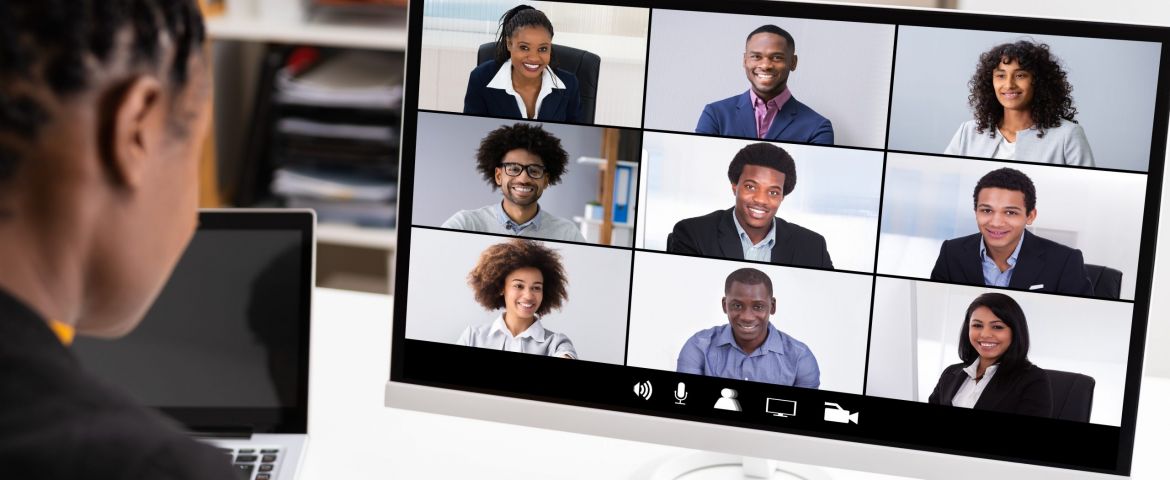Thanks to the COVID-19 pandemic, many companies have been working remote full-time for over a year. While at first it seemed like a refreshing chance to work in slippers and cozy hoodies, it quickly got chaotic as everyone struggled to move all business operations and meetings virtual, and calendars begin to fill up with video meeting links, Webinars and virtual events.
Now, a year later, virtual fatigue has set in thanks to way too much screen time and really missing the human interaction of working in the office with colleagues. In fact, according to HR Executive, a new study showed 76% of professionals surveyed participate in virtual meetings, with 30% saying they spend nearly one-third of their workday on camera. Even more telling: 38% admitted to video call fatigue since the pandemic and 26% say the practicality and novelty of videoconferencing has worn off over the past eight months.
Stanford researchers identified four main reasons why what’s been dubbed “Zoom Fatigue” is happening.
- Excessive amounts of close-up eye contact is highly intense. Have you noticed? The amount of eye contact on video chats and the size of faces onscreen is unnatural. In an in-person meeting, listeners can look at the speaker only, take notes, or look at each other one-on-one. But on a video call, everyone is staring into the screen at everyone − the whole time.
- Seeing yourself during video calls constantly in real-time is fatiguing. Most video platforms show a square of what you look like on camera. But that’s unnatural, similar to someone following you around to in-person meetings all day as you talk to people, make decisions, give and get feedback. And when you see yourself all day long, you’re more critical of yourself. (Have I always been that pale? I look tired today.) That kind of pressure can be mentally taxing.
- Video chats dramatically reduce our usual mobility. A full day of video meetings may have you chained to one spot compared to in-person or phone only conversations that allow you to walk around to move throughout the day. Video meetings force an unnatural limit to movement and with research showing that physical exercise helps employees perform better at work, it’s no wonder fatigue has set in.
- The cognitive load is much higher in video chats. There’s so much more to think about and do when videoconferencing compared to regular face-to-face interaction. On video, you have to work harder to send and receive signals such as showing you agree by nodding or putting thumbs up, typing in the chat section, etc. The Stanford researchers describe this as “using mental calories to communicate.” Or if a pet or child walks into the room, you may look away − which can cause stress if you fear the presenter will think you’re not listening or are bored with the meeting content. When we’re together in person, nonverbal communication is more natural − with gestures and nonverbal cues happening subconsciously and more effortlessly.
So now you know that it’s scientifically proven that “Zoom Fatigue” is real and not just you feeling overwhelmed, is there anything you can do about it? After all, according to Forbes, the percentage of workers permanently working from home is expected to double in 2021 and 74% of companies plan to permanently shift employees to remote work after the pandemic ends. The answer is – yes! With these tips from remote working pros.

1. Make time for small talk.
In an in-person meeting, there’s often time as you’re entering a room for casual chatter before the meeting starts or after the agenda wraps up, which can be fun and relaxing and not just all business. Experts say you should apply the same model to business video meetings. Try asking what everyone’s weekend or lunch plans are before the meeting officially starts or end the meeting with “tell me something good” in your life to wrap on a positive note.
2. Change up your screen view.
Whether you’re using Zoom, Google Meet, Microsoft Teams or another videoconferencing platform, try taking it out of the full-screen mode to reduce the size of yours and others’ faces. You can change up your tech for a better view too, with an external keyboard so you can back away from the monitor to increase personal space between yourself and the attendee grid. Or try an external camera placed farther away than the one built into your laptop. This could allow to even stand up and move about the room more, like you would if you were whiteboarding at an in-person meeting.
3. Limit video for when video is truly needed.
Cancel or shorten any unnecessary video meetings if it’s a slower day or shorter agenda for screen break/focus time. Turn a meeting into a 1:1 phone call if you just need to have a conversation, but don’t need to “see” each other or screen share any documents or presentations. As vaccinations ramp up, can you meet in person individually or in a small group at a centrally located park with masks and social distancing? It’s a nice break from your computer and a chance to get some exercise in, too. Turn off your camera if you’re attending a meeting just to “listen” and not present – so you’re not staring at (and critiquing) yourself. Build in purposeful “audio-only” breaks into a longer video meeting so everyone can get a break from staring into a grid of faces for too long and a mental energy rest from all those video nonverbal cues. During these breaks, stand up and stretch and look away from the screen. Don’t just keep checking email or texts!
4. Schedule smarter.
Avoid back-to-back, hour-long video meetings all day, all week long. Instead of scheduling meetings for 1-2 hour blocks, try a 45 minute meeting so everyone has 15 minutes to stand up, stretch and refresh before the next block of meetings. Or, build in “bio breaks” or “audio pauses” into your agendas so attendees can grab a water or coffee, let the dogs in, check on the kids or run to the bathroom without the risk of staying on video and bringing their laptop with them. Want to get in a lunch, coffee or tea break, or quick workout away from your desk? Build it into your calendar, just like you would a meeting or appointment. If it’s blocked, even for 10 or 15 minutes, others can’t schedule a meeting if you’re “in another meeting” – even if that meeting is walking your dog around the block for a screen break.

5. Brighten up your background.
If you have to stare at yourself for hours each week, and others do too, you might as well do a little springtime refresh to your work space. You’ve probably already played around with the available or customized virtual backgrounds, so it might be time to spice up your real space. Try relocating near a window for more natural light, or invest in a mini ring webcam light if you feel your home office space is too dark. Look at the area behind you – could it benefit from some colorful art, patterned curtains, a lamp or something green and living? According to a 2020 Hort Technology study, simply looking at a green plant for three minutes can reduce office fatigue and stress. Give yourself and your co-workers the gift of green health benefits. If you’re able to, consider moving outside to work − not only will you appreciate the change of scenery and sunshine on your face, all meeting attendees will too.
6. Dress like you’re going to the office.
We get it, stretchy pants and fuzzy slippers are cozy. But you’ve had more than a year of that, and spring is here – so try changing it up for certain meeting-heavy days or critical meetings. Because when you look good, you feel good! Dust off those blazers and blouses. Guys can put on a tie or ladies can easily add some colorful, bold jewelry. Remember, the most important look for video calls is really only from the waist-up. You can still don your favorite socks or comfy bottoms.
For those who wear makeup, beauty pros nationwide offer these easy tips to freshen your face for video meetings: A matte bronzer under cheekbones and jawline adds a lifted look. A peach-toned eyeliner on your lower lash line can brighten your eyes if you’re looking tired. If you like using less makeup (and saving money, too), beauty editors agree all you really need to pop more on camera is some mascara and a quick brush of a favorite lipstick or bright gloss.
7. Make video meetings fun with non-business agendas.
Break up your day and your team’s day with video meetings that aren’t all work and no play. Schedule a Zoom lunch and have everyone order carryout or share their favorite home lunch hack. Or, make 4pm every Thursday a virtual Happy Hour with cocktails. Get creative during team meetings with trivia, scavenger hunts and more. From games to show-and-tell, use these fun team building ideas to make video meetings more than just everyone staring at each other for an hour.
8. Commit to rituals before and after work.
What used to be your daily commute to the office is important time to ramp up for your workday, and then debrief before heading home. Mental health experts say rolling out of bed and going right to work or wrapping up your last call and then heading into the kitchen to immediately make dinner or be with the kids isn’t healthy. Your body and mind need that transition time. So – build in 15-30 minutes or more into your calendar in the morning for coffee or tea and reading, meditation or breathing/stretching. And then at the end of the day, block time just like you would a meeting to head outside for a walk, take the dog around the block, call a friend or sit on the couch with a good book before moving into your evening activities.
The reality is things will never be exactly the same after the pandemic ends. But with some creativity and test-and-learns, you can try these tips to find what works best for your schedule, and your team. Here are some more work-from-home tips, including resources if your “Zoom Fatigue” is becoming a more serious issue and you could benefit from professional help.
When all else fails, rest your eyes and take a screen break. You’ve earned it!


